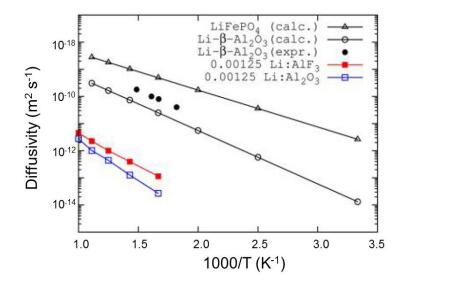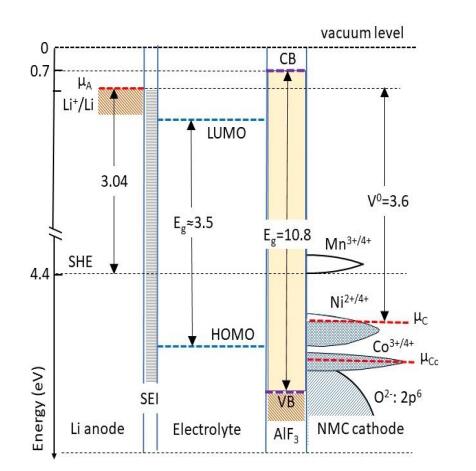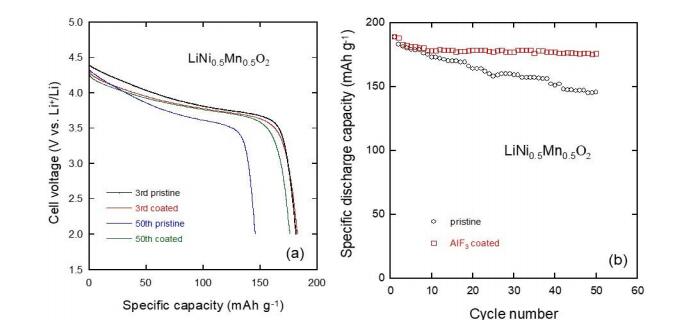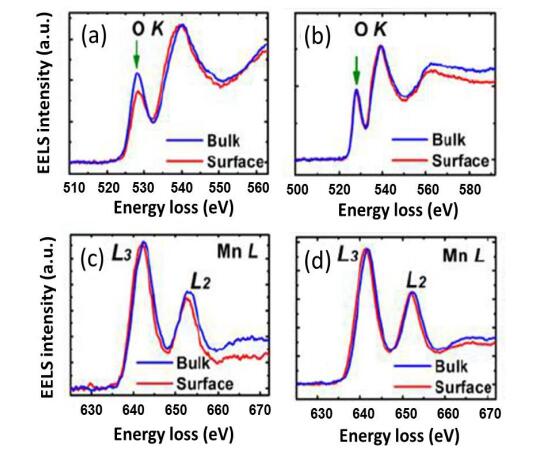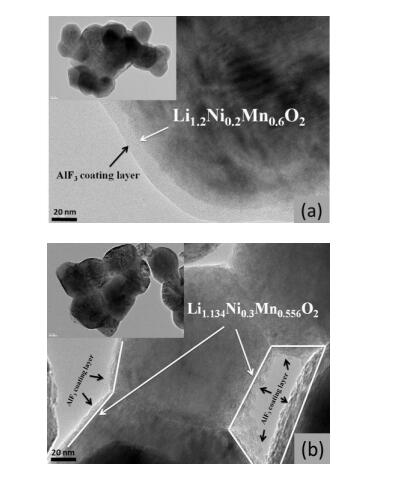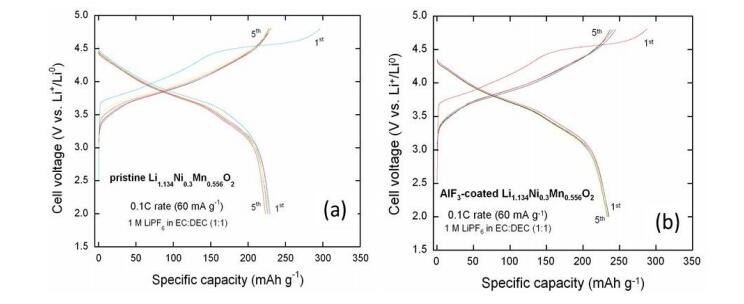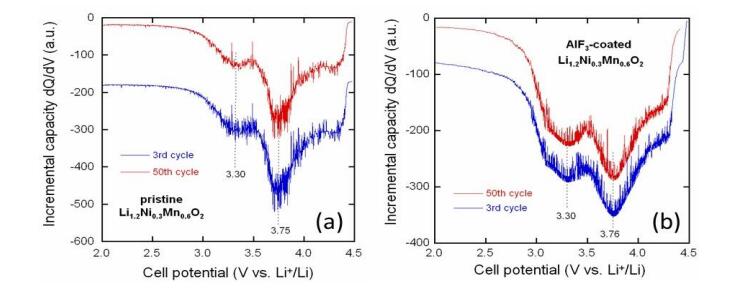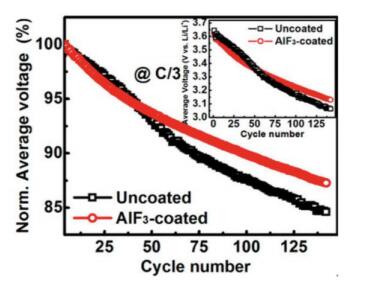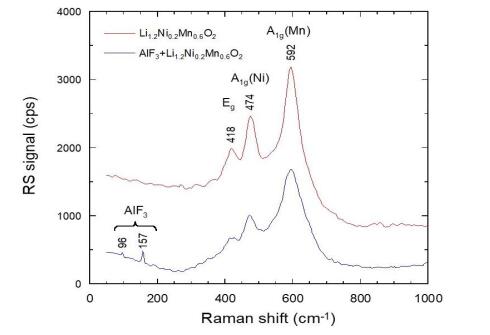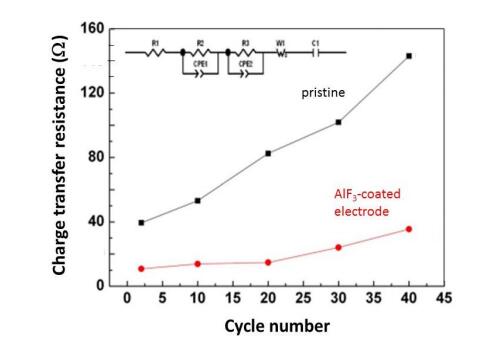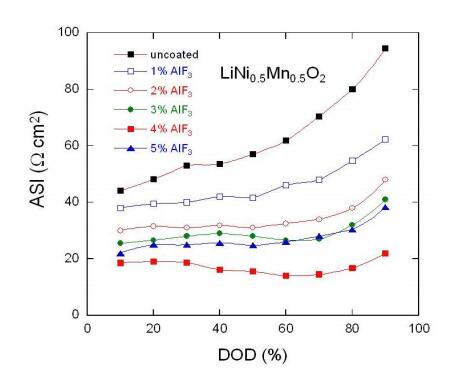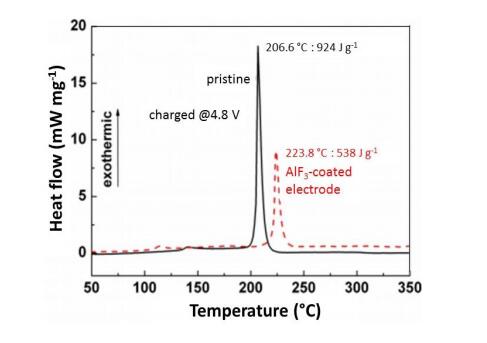1.
Introduction
The research on optimized electrode materials for Li-ion batteries aim at enhancing the energy density and the power density, improve the calendar and the cycling life, without compromising the safety of the cells [1]. In spite of these efforts, practical applications are still hindered by severe capacity fading during cycling and poor rate capability due partly to side reaction at the electrolyte–electrode interfaces (EEI). During long-term cycling, several unwanted degradation mechanisms occur (Figure 1a) such as oxidation of the electrolyte at high potentials, formation and growth of the solid electrolyte interphase (SEI), transition-metal dissolution, growth of a layer-to-spinel surface layer, unreacted residual lithium ingredients on the particle surface (i.e., LiOH, Li2CO3, which are dominant with Ni-rich oxides), formation of corrosion pits and occurrence of inter-granular cracks inside primary particles and severe etching/corrosion by the acidic species in the electrolyte (HF attack) [2,3,4,5,6,7,8]. Note that the formation of HF originates from the reaction of the lithium salt LiPF6 used in common electrolyte of Li-ion cells and trace amounts of water (or alcohols) described by [9]:
The existence of water, even in very small concentration, generates HF and causes breakdown of the electrolyte. If decomposition of the electrode material occurs by HF attack, byproducts are inevitably gathered. During extensive cycling, the HF attack on LiCoO2 electrode, for instance, can generate byproducts from Co on the surface of active particles. Then, these byproducts having Co–F bonding can be detected by spectroscopy assuming the relations [10]:
These byproducts would adhere at the surface of the separator and enhance the internal resistance of the Li//LiCoO2 cell.
Several strategies have been directed to ameliorate the cycling performance of cathodes. Four representative tactics are currently used: (ⅰ) surface coating/modification [11,12], partial substitution of cations [13], partial substitution of oxygen anion [14] and utilization of electrolyte additives [15]. Moreover, some works have successfully associated doping and coating to enhance the electrode performance [16,17]. In most cases, surface engineering was realized by the deposition of a thin protective layer that covers uniformly the active particles (Figure 1b). Optimizing the surface region of a layered oxide is of prime importance because the outer area of a particle experiences the Li-ion path for insertion/deinsertion reaction. Hashem et al. [18] demonstrated that one function of coating is the crystallization of the thin disordered layer on the surface of LiNi1/3Co1/3Mn1/3O2, which improves the electrochemical properties. Other functions of the coating layer can be described considering two mechanisms: (ⅰ) the coat acts as a barrier to the electrolyte infiltration effect that reduced the electrolyte-electrode reactions and (ⅱ) the coating works as an HF scavenger. Numerous oxide materials used as protective coatings have proved to maintain the stability of the electrode–electrolyte interface in Li-ion batteries [11,12].
Electrode materials have been successfully coated with metal fluorides, i.e., LaF3, MgF2, ZrF4, CaF2, SrF2, YF3, AlF3 [19,20,21,22,23,24,25,26,27,28], and metal oxyfluorides, i.e., ZrOxFy, BiOF and YOF [29,30,31]. Generally, fluoride coatings demonstrate higher stability than most metal-oxide coats and potent erosion resistance against the HF in the electrolyte. Lee and Park [22] showed that a MgF2 coating layer deposited by co-precipitation technique onto LiCoO2 thin-film electrode reduces the dissolution of Co and the surface damage during cycling at 45 ℃. The 1 wt% MgF2 coating of LiCoO2 by chemical deposition improves the electrochemical performance with was optimized of MgF2 but fails to increase significantly the thermal stability [32]. The crystalline 2 mol% SrF2 coating on LiMn1/3Ni1/3Co1/3O2 (NMC333) powders suppresses the increase of the charge-transfer resistance during cycling over the voltage window 2.5–4.6 V vs. Li+/Li [26]. Coating NMC333 with LiF eliminates the increase in the charge transfer resistance that occurs for long cycling and during storage in the charged state [33]. Coating LiCoO2 particles with ZrOxFy by a chemical deposition method leads to similar results, in which case the ZrOxFy deposit was obtained via adding NH4F in Zr4+ aqueous solution with a controlled Zr:F ratio of 1:4 [29].
Note, however, that the beneficial effect of the layer coating is strongly dependent on the nature and morphology of the coating material. As the MF3 fluorides are more stable than most of the other compounds under the corrosion of HF, the main effect of the coating with fluorides is an improvement of the electrochemical performance owing to the decrease of the dissolution of the active electrode material and protection against HF attack. Indeed, LaF3 coating has significantly improved both the rate capability and the cycling performance of LiCoO2 [19] and LiMn2O4
[34] as well. Another good reason to use AlF3 as a buffer layer is its excellent protection for the aluminum collector from corrosion by the conventional electrolyte including LiPF6 as the lithium salt. Moreover, Al is a light and cheap element. These features explain the superiority of AlF3 and its success over the other metal fluorides as a protective coat of the electrode materials.
Metal fluorides can be used in lithium batteries in many ways. On a historical point of view, they have first been studied already in the 1960s for application as electrodes in primary lithium batteries, because they act as conversion materials, forming lithium fluoride during discharge, leading to large capacities and energy densities reported in different reviews [35,36]. However, the huge change of volume associated to the conversion reaction and the fact that the reaction is only partially reversible prevent their practical use as electrodes for secondary (i.e., rechargeable) batteries. Some recent progress has been made by mixing nanoparticles of metal fluorides such as BiF3, FeF2, FeF3 [37,38] and AlF3 [39] with carbon to buffer the product of the reaction. However, LiF is a product of the conversion reaction, which is one of the most insulating material on earth, which results in large overpotentials and high resistance, so that the electrode works only at very low C-rates, i.e., at very small currents. For example, the AlF3–carbon composite only works at 0.1C, and still only 4% of the initial capacity is maintained after 10 cycles [39], precluding the practical use of this material as an electrode in the rechargeable lithium-batteries considered here. In practice AlF3 is suitable only for electrode protection because it is rather inert and the Al3+-ion cannot be reduced or oxidized in battery conditions [11].
Hereunder, we review the different effects of AlF3 coating, namely (1) electrode protection agent, (2) safety protection medium, (3) Al corrosion inhibitor, and (4) HF scavenger, and the resulting improvement of the electrochemical performance depending on the cathode material. After a brief description of the AlF3 phase including synthesis methods and transport properties, we consider the different AlF3-coated materials used in Li-ion batteries.
2.
Aluminum fluoride coating material
2.1. Structural properties of AlF3
Aluminum fluoride possesses five known varieties, i.e., α-,
β-, η-, κ-, τ-AlF3 [40], out of which α-AlF3 is the most thermodynamically stable phase (perovskite-like form). It crystallizes with a rhombohedral structure (space group R-3c) and is thermodynamically stable at room temperature. The lattice has two equivalent stable interstitial sites per primitive cell, which can be occupied by lithium ions; they are located at the center of each distorted cube of α-AlF3 at (${}^{1}\!\!\diagup\!\!{}_{4}\;,{}^{1}\!\!\diagup\!\!{}_{4}\;,{}^{1}\!\!\diagup\!\!{}_{4}\;$) and (${}^{3}\!\!\diagup\!\!{}_{4}\;,{}^{3}\!\!\diagup\!\!{}_{4}\;,{}^{3}\!\!\diagup\!\!{}_{4}\;$) coordinates. The β-AlF3 metastable phase crystallizes with an orthorhombic structure (Cmcm space group). α-AlF3 is a dielectric compound with a low refractive index, wide bandgap ~10.8 eV and strong Lewis acidity [41]. Due to its interesting optical, electrical and magnetic properties, a metal fluoride such as AlF3 is an interesting compound for a wide variety of applications including optical designs, ionic conductors, protective coatings for electrodes in Li-ion batteries, heterogeneous catalyst and ferroelectric components [42,43,44]. With a low Gibbs free energy of formation, the advantage of AlF3 against the amphoteric Al2O3 coating has been demonstrated from the exposure to trace of HF [45]. Therefore, a non-negligible advantage is that the AlF3 coating layer appears to be a good Li+-ion conductor after lithiation. Interestingly, LiPF6 is the lithium salt actually used in the commercial Li-ion batteries. LiPF6 is chosen not only because the very good ionic conductivity, but also due to its ability to form an AlF3 layer protecting the aluminum current collector against electrolyte corrosion. The efficient effect of passivation of the current collector surface by AlF3 coat is known since a long time [46,47].
The corrosion of Al current collector (CC) foil has been recently revisited by Ma et al. [48]. The natural Al2O3 passivation layer promotes the deprotonation of the cationic radical of ethylene carbonate (EC+), which provokes the decomposition of PF6- anion and forms a proton-resistive AlF3 layer on the Al surface. XPS measurements of the binding energy show that a CC foil anodized at 3.9 V for 20 h displays the conversion of the Al2O3 layer (75.6 eV) to stable AlF3 passivation film (77.2 eV). Methyl difluoroacetate is used as fluorinated solvent that facilitates the formation of AlF3 to passivate the surface of Al foil [49].
2.2. AlF3 deposition methods
Various methods have been utilized to prepare AlF3-coated lithiated materials: (a) chemical deposition or coprecipitation process [45], (b) atomic layer deposition [50,51,52,53], and (c) solid-state reaction [54]. The most popular technique used for AlF3-coating is the chemical precipitation route. In this process, aluminum nitrate dehydrate, Al(NO3)3 and ammonium fluoride, NH4F, are separately dissolved in distilled water as precursor solutions. The pristine powders are immersed in Al(NO3)3 dilute solution, whose pH is adjusted at value of 7.0 by adding ammonia solution, heated to 50 ℃ and stirred vigorously. NH4F dilute solution is then added into the solution drop by drop. The molar ratio of Al to F is controlled to be 1:3, and the various amounts of AlF3 are 2–15 wt% for coated Li-rich layered oxides. The mixed solution containing the cathode powders is stirred at 80 ℃ for 5 h to ensure the slow evaporation of solvent, and then dried at 60 ℃ in a vacuum oven. The final coated powders are obtained by heat treatment at 400 ℃ under flow of argon (or nitrogen) for 4 h to prevent the formation of Al2O3 and secure the formation of AlF3-coated Li-rich oxide. The overall reaction for the AlF3 deposit can be expressed by:
which occurs in the solution reaction at room temperature, and the departure of NH4NO3 during the heat treatment in nitrogen atmosphere at 400 ℃:
In the atomic layer deposition (ALD) process, trimethylaluminum (TMA) and anhydrous hydrogen fluoride are developed for the deposition of AlF3 at substrate temperatures between 100 and 200 ℃. Gaseous HF source (pressure of 10 kPa at room temperature) is HF-pyridine, which enables the safe handling of anhydrous HF [50]. A typical deposit process is designed by 1 s dose of TMA injection, 30 s of N2 purge, 1 s dose of TMA injection and 30 s of N2 purge that produces a linear growth of AlF3 with a mass gain of ~30 ng·cm-2 per cycle. Jackson optimized the ALD AlF3 coating onto LiNi0.5Mn0.3Co0.2O2 cathode powders using a Al(CH3)3/TaF5 precursor combination that obviates the utilization of highly toxic HF(g)
[54]. The freestanding LiCOO2/multiwall carbon nanotube (LCO-MWCNT) electrodes were coated with 2 ALD cycles of AlF3 conducted at 150 ℃ [55]. TMA and HF derived from HF–pyridine solution were used as precursors in the ALD process according the reactions [51]:
showing that AlF(CH3)2 fluorinated by the HF exposure is the key intermediate reaction to produce AlF3 growth. The AlF3 coating realized by solid-state reaction consists in the sintering at 970 ℃ for 15 h of the mixture of AlF3 powder (particle size ~400 nm) with the precursor of the electrochemically active material and Li2CO3 (5 wt% excess) [54]. AlF3- and LaF3-coating LiCoO2 electrodes were also prepared by spin-coating method and thermally treated at 400 ℃ for 30 min [56].
2.3. Transport in AlF3 coating
Lithium transport through surface coatings has been theoretically examined by several groups using first-principles calculations based on density functional theory [57,58,59]. A host supercell containing diluted concentration of Li atoms was considered for amorphous AlF3 (a-AlF3) with NLi/Nhost ratio of 100:80, 000 [57]. The self-diffusion coefficient (Ds) vs. temperature was represented by an Arrhenius law:
where D0 is the diffusion prefactor and Eeff the effective activation barrier, with the fitting parameters D0 = 7.7 × 10-9 m2·s-1 and Eeff = 0.65 eV for a-AlF3 coating (Figure 2). Xu et al. [59] studied the diffusivity of interstitial lithium in crystalline α-AlF3 and amorphous a-AlF3. For an electronically insulating conformal coating, the transport of Li+ ions, which are the unique mobile charge species, is driven by an electric field. To balance the positive charge of Li+, there is a compensating negative charge in the coating, which is assumed to be immobile. This model referred to as "electrolyte model" [59] has been shown to be consistent with experimental works [60,61,62]. Li ions can diffuse by hopping from one interstitial site surrounded immediately by 8 oxygens to nearest site at a distance of 3.59 Å throughout a saddle point and must cross a barrier height Em = 0.929 eV in the process. Predicted transport properties for crystalline and amorphous AlF3 coatings are summarized in Table 1 [59], which illustrates that the lithiated AlF3 contains Li–Al–F bonds and acts as a stable lithium conducting solid electrolyte. A mechanism has been proposed for the accommodation of the Al-F coating at the electrode interface [63]. As a consequence of the small charge transfer resistance, the Al-F coating layer facilitates the Li+ insertion/extraction at the interface. After heat treatment, the coating film is formed with an inner amorphous Li-Al-F layer such as LiAlF4, which has been reported as a good lithium fast-ion conductor with a conductivity of 1 × 10-4 S·m-1 at 25 ℃ [63]. The LiAlF4 structure is constituted by a network of corner sharing AlF6 octahedra and Li ions are primarily associated with non-bridging fluorine atoms [64,65]. Among the thermodynamically possible reactions, AlF3 converts to the high intrinsic Li-ion conducting Li3AlF6 according to:
at potential E = 1.28 V Li+/Li [66]. Li3AlF6 is a stoichiometric ternary mixture of LiF and AlF3 exhibiting a high ionic conductivity of 10-6 S·cm-1 [67]. Therefore, the morphology and microstructure of the final phase of AlF3 are affected by the deposition methods. As an amorphous-like phase is requested for preventing low migration barrier values, using a moderate post heat-treatment of the AlF3 deposit, the co-precipitation synthesis is the best method that generates a non-crystallized material. Similar precautions are currently taken into account for coating made by ALD technique, for which a low substrate temperature is maintained below 200 ℃. The amorphous state of AlF3 coating has been evidenced by several authors using HRTEM measurements (see Ref. [8] for example).
2.4. Relative energies in Li-ion battery
Figure 3 is a schematic representation of the relative energies in a Li battery. The equilibrium working voltage V0 is given by the difference in chemical potential between anode (μA) and cathode (μC) for a given redox couple, i.e., 3.6 V vs. Li+/Li for the Ni2+/3+ couple in the LiNi1/3Mn1/3Co1/3O2 host [1]. The electrochemical stability of a Li battery is determined by the electrochemical stability window (ESW) of the electrolyte or bandgap energy Eg:
where EHOMO and ELUMO are the energy of the highest occupied molecular orbital (HOMO) and the lowest unoccupied molecular orbital (HOMO), respectively. The condition for stability is given by:
where n is the number of electrons involved and F is the Faraday constant. Since μA of the lithium anode lies above the LUMO, the electrolyte is reduced to form a passivating SEI film that allows the diffusion of Li ions through the layer under a uniform electric field and prevents the decomposition of the electrolyte. On the cathode side, μC acts as a redox couple for the active transition-metal cation containing localized d-electrons in the d-manifold, e.g., Ni2+/4+ in the NMC host material. During the charge/discharge process, the Fermi level EFC is moved from one formal electronic state to another upon oxidation/reduction of the host. However, for the positive electrode in the charged state (E > 4.5 V), EFC approaches the bottom of the Co3+/4+ redox couple (μCc potential), which interferes with the top of the anion p band (O2-: 2p6) of the host and destabilizes the host by release of oxygen [68]. At this point, the cell voltage is also limited by the ESW of the electrolyte and a situation becomes similar to the anode side: μCc lies below the HOMO level (located at 4.3 eV below μA(Li)) implying decomposition of the electrolyte unless a passivating SEI film blocks the reaction [69]. A thin insulating layer applied on the surface of the cathode acting as buffer isolates the host from the electrolyte. As shown in Figure 3, the AlF3 coating possessing a bandgap of 10.8 eV has an EHOMO energy level much lower than that of the electrolyte, even in the upper state of charge (SOC) of the cathode. Note that cyclic voltammetry shows the ESW of LiAlF4 is 2.75–4.5 V vs. Li+/Li. However, the presence of such a film causes an increase in the internal resistance of the cell and consumes a portion of the lithium amount of the cathode [70].
3.
AlF3-coated materials for Li-ion batteries
AlF3 coating was used to enhance the performance of various cathode materials for Li-ion batteries including layered structures such as LiCoO2 (LCO) [28,53,71,72,73], LiNi1-yMnyO2 (NMO)
[74,75], LiNixMnyCozO2 (NMC) [76,77,78,79,80,81,82,83,84,85,86], Li-rich NMC (LNMC) [54,66,75,87,88,89,90,91,92,93,94,95,96,97,98,99], LiNi1-x-yCoxAlyO2 (NCA) [100,101,102,103,104], spinel structures such as LiMn2O4 (LMO)
[105,106,107,108,109,110], LiNi0.5Mn1.5O4 (LNM) [111,112,113], olivine structures LiFePO4 (LFP) [114,115,116] and LiCoPO4 (LCP)
[117]. AlF3 coating has been also experimented on anode materials such as graphite and Li4Ti5O12, in which case the deposit suppresses the gas generation [118,119,120,121].
3.1. AlF3-coated LCO
LCO cathodes show significant degradation of electrochemical behaviors above 4.5 V. At such high voltage, AlF3 coating is a solution, while Al2O3 is not, because of the partial conversion of the layer to metal fluoride by HF attack producing H2O [122]. The beneficial effect of the surface modification of LCO particles by AlF3 coating was first reported by evaluating laminated-type full Li-ion cells [123]. While the capacity of the uncoated LCO/C cell vanished rapidly after 500 cycles, the AlF3-coated LCO cell showed excellent capacity retention of 91% at 1C rate in the range 3.0–4.5 V. Following this report, early analyses of AlF3 coating on LiCoO2 cathode particles was reported in Refs. [28,71]. The 0.5 mol% AlF3 deposit shows a thin layer (5–10 nm thick) on the surface of LiCoO2, which becomes thicker around 20–30 nm when the coating amount is 1 mol% [28]. This small deposit amount is sufficient to realize good performance with capacity retention of 97.7% after 50 charge–discharge cycles and capability of 93.1% at 5C rate. An LCO electrode coated with 2 mol% AlF3 was able to deliver 208 mAh·g-1 at 4.54 V upper cutoff voltage. The amount of Co dissolution of this electrode charged at 4.5 V as a function of the storage time in electrolyte at elevated temperature of 55 ℃ was compared with that of pristine material. Results show a concentration of 47 ppm for pristine LCO stored for 6 weeks, against only 19 ppm for the coated electrode [72]. DSC measurements of LiCoO2 electrodes charged at 4.4 V and uniformly encapsulate by a 10–15 nm thick AlF3 layer show that the exothermic peak associated with the thermal decomposition is at 273.5 ℃ and the reaction enthalpy is 392 J·g-1, against 208.5 ℃ and 544 J·g-1, respectively, for the bare materials [73]. This result demonstrates that the AlF3 layer improves the thermal stability. This AlF3-coated electrode allows a charge regime at high voltage of 4.6 V vs. Li+/Li delivering a specific capacity of 160 mAh·g-1. Recently, Zhou et al. [53] fabricated freestanding LiCoO2/multiwall carbon nanotube nanocellulose fibril (LCO-MWCNT-NCF) composite electrodes coated with AlF3 layer. The AlF3 deposit was realized with 2 ALD cycles, leading to a high specific capacity of 216 mAh·g-1 at 4.7 V for LCO-MWCNT-NCF electrodes. In contrast, when coated with 2 ALD cycles of Al2O3, LCO-MWCNT-NCF electrodes cannot be cycled above 4.5 V due to the higher LUMO energy level.
3.2. AlF3-coated NMO
The single-phase LiNi1-xMnxO2 (NMO) exhibits a specific capacity of 150 mAh·g-1 with the formal charges of Ni and Mn of 2+ and 4+, respectively, only the Ni2+/4+ redox couple being available. However, the electrochemically inactive Mn4+ provides significant structural stability [124]. LiNi0.5Mn0.5O2 cathode materials prepared by quenching treatment and coated with AlF3 by conventional coprecipitation method show initial discharge capacity of 175 mAh·g-1, decreasing to 153 mAh·g-1 after 50 cycles at 0.1C rate (28 mA·g-1). At high current density of 5C rate (1.4 A·g-1), this coated electrode delivered 120 mAh·g-1 at in the voltage range 2.5–4.5 V [125]. Time-of-flight secondary ion mass spectroscopy was used to investigate the effect of a ~10 nm AlF3 deposit on LiNi0.5Mn0.5O2 electrode [74]. The insulating LiF outer layer originating from the LiPF6 decomposition was suppressed by the AlF3 coating with the benefit of the reduction in the charge transfer resistance. Figure 4 shows the electrochemical features of pristine and AlF3-coated Li[Ni0.5Mn0.5]O2. The surface modification using 2 wt% AlF3 of layered oxide improved significantly the cycling stability of the electrode [75], which retained a specific capacity of 175 mAh·g-1 after 50 cycles at C/2 rate in the voltage range 2.0–4.4 V (Figure 4a). This corresponds to a capacity retention of 93% with an excellent coulombic efficiency of 99.5% much higher than that of the pristine material (Figure 4b).
3.3. AlF3-coated NMC
Cathodes based on Li[NixMnyCoz]O2 (NMC) compounds with x + y + z = 1 are actively studied as the new generation of stable high-specific-energy cathode materials for Li-ion batteries [126]. In an early work, Woo et al. [76] investigated the electrochemical performance of the AlF3-coating of Ni-rich LiNi0.8Co0.1Mn0.1O2 (NMC811) cathode materials and examined the stabilized electrolyte/electrode interface. A 10-nm thick coating on NMC333 powders was obtained using 0.25 mol% of AlF3 in the sol-gel solution [77,78]. Regardless the cycle life of AlF3-coated LiNi1/3Co1/3Mn1/3O2 electrodes, Sun et al. [77] determined that the charge transfer resistance (Rct) was stable under the high voltage cutoff of 4.6 V. The surface of the layered LiNi1/3Co1/3Mn1/3O2 cathode materials was modified by covering the particles with a 10 nm thick AlF3 layer deposited by the conventional coprecipitation technique. Electrochemical tests showed an improvement of the performance at high cutoff voltage of 4.5 V, with a capacity retention of 81% after 800 cycles and a decrease of the area specific impedance even at the discharge rate of 10C [79]. About 3 nm thick uniform AlF3 coating (1.5 wt%) on the surface of LiNi1/3Co1/3 Mn1/3O2 limited the capacity fading at 3% when cycled 80 times in the voltage range 2.8–4.3 V at 2C rate [80], which is better than the 93.5% capacity retention obtained at 1C at 60 ℃ after 50 cycles for the LiF-modified LiNi1/3Co1/3 Mn1/3O2 electrode [81]. AlF3-coated LiNi0.45Mn0.45Co0.10O2 as cathode material [82] delivered an almost stable specific capacity of ~145 mAh·g-1 when discharge at the rate of 0.1C (20 mA·g-1) in the voltage range 2.5–4.5 V. The thermal behavior of AlF3-coated LixNi1/3Co1/3Mn1/3O2 was studied in the charged state, i.e., in the delithiated Li concentration x = 0.35. TGA and high-temperature XRD data showed that the phase transition from rhombohedral Li0.35MO2 to spinel Li0.7M2O1.933 structure appearing at 450 ℃ is induced by a slight amount (~0.07 mol) of released oxygen. The decrease of oxygen loss (~0.04 mol) was detected for the AlF3-coated Li0.35Ni1/3Co1/3Mn1/3O2 electrode, which retards the formation of the spinel phase. It was concluded that the AlF3 coating layer played two roles at the particle surface: (i) a protection against oxygen loss and (ii) a sacrificing for the formation of Li-Al-O and Li-Al-F complexes [83]. Using dual deposition process of metal fluorides, the co-effect of 1 wt% AlF3 and 1 wt% MgF2 coated layers on the electrochemical properties of NMC333 was studied under high voltage in the range 2.8–4.7 V. In that case, the coated electrode delivered an initial capacity of 207 mAh·g-1 at C/5 discharge rate [127]. Commercial LiNi0.5Mn0.3Co0.2O2 powders (NMC 532, from ECOPRO Co., Korea) were coated with either AlF3 or LiLaPO4 to fabricate a blended cathode [84]. The synthesis was realized with 0.25 wt% AlF3 of the NMC532 powder in the solution, which increases the thermal stability of the electrode charged at 4.6 V. Owing to the coating, the exothermic DSC peak shifts from 230 to ~280 ℃ and the heat generation decreases from 186 to 100 J·g-1 compared to uncoated particles. Spherical NMC532 particles were coated with different AlF3 concentrations in the molar ratio range 0.25–2.0 [85]. A combination of XRD data, galvanostatic charge/discharge tests and EIS measurements showed that 0.5 mol% AlF3 coating is the best content providing a high specific capacity of ~160 mAh·g-1 at 6C rate in the voltage range 2.8–4.5 V. Yang et al. [85] coated the surface of LiNi0.5Mn0.3Co0.2O2 (NMC532) by coprecipitation method, the amount of AlF3 being set at molar ratios nAlF3/nNMC532 in the range from 0.25 to 2%. It was demonstrated that oxygen vacancies favor the Li+-ion transport and increase the capacity in forthcoming cycles. An important advantage of the AlF3 coating layer is the termination of the increase of cell impedance upon charge–discharge process by preventing directly the SEI formation. The AlF3-coated NMC532 operating at 4C over 2.8–4.5 V had capacity retention of 98% (initial specific capacity of mAh·g-1) after 100 cycles. Ni-rich LiNi0.8Mn0.1Co0.1O2 electrodes (NMC811) with AlF3 interfacial layer deposited by ALD technique from AlCl3 and TiF4 precursors kept at 120–130 ℃ were investigated in the voltage range 2.75–4.5 V vs. Li+/Li. The average specific capacity of AlF3-coated NMC811 cathode was 184 mAh·g-1 at 20 mA·g-1 current density and 106 mAh·g-1 at 200 mA·g-1 [66].
3.4. AlF3-coated Li-rich layered NMC cathodes
The lithium-rich Li[LiδNixMnyCoz]O2 (NMC) compounds with δ + x + y + z = 1 layered oxides (LNMC) are inter-grown composite structures xLi2MnO3·(1 - x)LiMO2 (M = Mn, Co, Ni), which have attracted a lot of interest as positive electrode (cathode) materials for Li-ion batteries because since the their high energy density of about 250 mAh·g-1 in the voltage range 2.0–4.8 V vs. Li+/Li [128]. Nowadays, they are considered as promising cathode element and used for powering electric vehicles (EVs). Surface analysis showed that surface‐modified Li[Li0.2Ni0.17Co0.07Mn0.56]O2 nanoparticles with 3 wt% of AlF3 deposited by chemical process (2 nm thick) exhibits a largely suppression of the undesirable growth of SEI layer. This 3 wt% of AlF3 coating enhanced the capacity retention to 83% and the cathode delivers a specific discharge capacity of 182 mAh·g-1 after 50 cycles when charged to 4.8 V vs. Li+/Li. In relation to the effect of the coating on the SEI formation, a detailed description of the complex surface chemistry of Li-rich layered cathodes can be seen in Ref. [86]. This decrease of impedance is responsible in turn for the improvement of the rate capability. For instance, the reversible capacity of the AlF3-coated Li(Li0.17Ni0.25Mn0.58)O2 at 5C rate was raised to 104 mAh·g-1 after 200 cycles, much larger than before coating. Electrochemical tests exhibited improved rate capability and life cycle behavior at elevated temperature of 55 ℃ with the best results for 0.5 mol% of aluminum fluoride deposit. Furthermore, the thermal stability studied by DSC showed a shift of the exothermic peak from 247 to 308 ℃ with lower exothermic heat release [87]. Using a combination of scanning/transmission electron microscopy (SEM/TEM) and electron energy loss spectroscopy (EELS) characterizations, Sun et al. [45] evidenced that the coating of Li[Li0.19Ni0.16Co0.08Mn0.57]O2 cathode enhanced the overall electrochemical features in contrast with the typical shortcomings of Li‐rich positive electrodes due to the Li chemical leaching effect of the AlF3 deposit transforming the initial Li2MnO3 layer to a spinel phase. Optimized electrode with 2 wt% AlF3 coating concentration delivered a specific capacity of about 206 mAh·g-1 when cycled between 2.0 and 4.6 V at a current density of 0.5C rate (125 mA·g-1) over 100 cycles. From the thermal stability view point, the 2 wt% coating reduces the exothermic reaction with a generated heat of 274 J·g-1 at 262.5 ℃.
A core shell material Li1.2Mn0.54Co0.13Ni0.13O2@AlF3/C (LMSAC) was synthesized by coating AlF3 and carbon hybrid deposit via sol-gel process. The LMSAC cathode delivered the initial specific capacity of 230 mAh·g-1 at 1C rate in the potential range of 2.0–4.8 V vs. Li+/Li and exhibited a capacity retention of 96% after 50 cycles [88]. The AlF3 surface-treated Li1.1(Ni0.15Co0.1Mn0.55)O1.95 layered oxide was cycled at 25 and 55 ℃. At elevated temperature, a capacity gain of 10% was attributed to the improved thermodynamic activation [89]. Li-rich Mn-based cathode Li[Li0.2Fe0.1Ni0.15Mn0.55]O2 particles doped with iron were artificially protected by 7% AlF3 nano-coating obtained by coprecipitation method [90]. It was stated that the fluorine source, NH4F, acts as a chelating agent that promotes a slow reaction with aluminum and more complete coating film. Upon 3-nm AlF3 coating, great structural changes were observed by TEM and electron diffraction measurements. An integrated layered-spinel structure was formed. An excellent performance with a specific capacity of ~120 mAh·g-1 was observed after 100 cycles at 20C rate. As AlF3 coat appeared to be uniform and thin (compared with the 15-nm Al2O3 layer), this protecting deposit is preferred to Al2O3 for the electrochemical behaviors that can be triggered by tuning the amount of coating. Zheng et al. [8] demonstrated the efficiency of AlF3 coating on Li-rich Mn-rich Li1.2Ni0.15Co0.10Mn0.55O2 electrode cycled at C/3 rate in the voltage range 2.0–4.75 V vs. Li+/Li upon cycle number. Quantitative analysis of the pre-peak of the O K-edge and the linear relation of L3/L2 EELS intensity with the Mn valence state at the particle surface and in the bulk showed the reduced formation of oxygen-deficient surfaces and the stabilization of the spinel-like phase (Figure 5).
Li1.17Ni0.25Mn0.58O2 with 5–7 nm thick AlF3-coating provided a high specific capacity > 250 mAh·g-1 at 0.2C rate, maintained at 104 mAh·g-1 when discharged high current density of 5C after 200 cycles. Such a material displayed improved coulombic efficiency from 76.4 to 89.5%. EIS analyses revealed that the AlF3 layer induces a pre-activation of the Li-rich layered oxide with a maintenance of more active Li sites during the insertion/extraction reaction [91]. The effects of AlF3 modifying cyclic performance of Li1.24Ni0.12Co0.12Mn0.56O2 cathode materials (LNCM@AlF3) were recently reported by Ding et al. [92]. A combined set of electrochemical tests showed that the best results are obtained with a proper coating of 2 mol% AlF3 (~7 nm in thickness). This homogeneous layer favored the diffusion ability of Li+ ions at the electrode/electrolyte interface and largely decreased Rct from 350 Ω in pristine to 59 Ω in LNCM@2%AlF3 electrode. LNCM@2%AlF3 operating at 55 ℃ delivered a specific discharge capacity of 219 mAh·g-1 at current density of 20 mA·g-1 after 50 cycles. Kim et al. [63] reported the positive effect of a controlled AlF3 coating on the Li-rich NMC electrode, namely 0.5Li2MnO3-0.5LiNi0.5Mn0.3Co0.2O2 (or Li1.2Mn0.52Ni0.2Co0.08O2). The authors attributed this improvement to the fact that the coating (nominal amount of AlF3 about 0.25 mol% of the LNMC material) leads to a Li–Al–F interface that acts as a stable lithium conducting solid electrolyte. At discharge rate of 0.5C in a voltage range of 2.0–4.6 V vs. Li+/Li, the Al-F coated electrode had an improved capacity retention (98% of the 216 mAh·g-1 initial capacity) compared to the pristine one (93% of the 206 mAh·g-1 initial capacity). The surface modification of Li[Li0.11Ni0.33Mn0.56]O2 with various amounts of AlF3 (0 ≤ AlF3 mol% ≤ 10) was realized by the precipitation routine setting the Al:F ratio to 1:3. After coating with 5% Al/F and heat treatment at 400 ℃, the particle had a core-shell structure: a disordered layer separated the crystalline LNMC bulk from the amorphous AlF3 outer coating. The electrode with low coating content (~1 mol%) had a specific capacity of 215 mAh·g-1 on charging to 4.6 V [93]. Wang et al. [94] claimed excellent electrochemical behaviors of the AlF3-coated Li1.2Mn0.534Ni0.133Co0.133O2 cathode that exhibited a discharge capacity of 222 mAh·g-1 (capacity retention of 96.5%) after 50 cycles at 1C rate. Li et al. [95] prepared an AlF3-coated Li1.2(Mn0.54Ni0.16Co0.08)O2 cathode materials via wet process. Optimized powders with 5–7-nm thick AlF3 layer exhibited a capacity retention of 72.4% after 50 cycles at 1C rate. Amalraj et al. [86] considered the detailed chemistry of the coating/active material and the electrochemical performance of Li and Mn rich xLi2MnO3-(1 -
x)LiMnyNizCowO2 powders (0.4 ≤
x ≤ 0.5) with an emphasis on the effect of 2–3 wt% AlF3 coating. TEM studies showed that the coating layer is formed of nano-crystals with tetragonal structure t-AlF3 (P4nmm space group) regularly distributed. Additionally, amorphous clusters Al-containing species, like AlF3, AlFxOy and Al[FOH] were detected by solid-state NMR measurements. Such AlF3-coated material exhibited specific capacity of ~250 mAh·g-1 at a C/5 rate, and high lithium storage capability at 60 ℃. Li- and Mn-rich layered oxide Li1.4Ni0.25Co0.10Mn0.65O2 was coated with a small amount of AlF3 (~11 vol%) by the conventional sol-gel route [96]. It was shown that during preparation the environmental Li excess caused the formation of Al2O3 and LiF that led the surface conversion from Li2MnO3 to self-generated LiMn2O4 spinel layer, which upgrades the electronic conductivity of particles.
AlF3 has been chosen as the inert coating material to protect the Li- and Mn-rich xLi2MnO3-(1 - x)LiMn0.5Ni0.5O2 particles with x = 0.3 (Li1.134Ni0.3Mn0.566O2) and x = 0.2 (Li1.2Ni0.2Mn0.6O2) [74]. Thickness of the amorphous AlF3 coating layers (5 wt% of the Li-rich layered oxide) uniformly deposited by the conventional coprecipitation method is 5 nm for Li1.2Ni0.2Mn0.6O2 particles (200-nm size) against 2 nm for Li1.134Ni0.3Mn0.566O2 ones (Figure 6). Figure 7 presents the galvanostatic charge/discharge profiles carried out at C/10 rate (30 mA·g-1) in the potential range 4.5–2.0 V vs. Li+/Li for (a) pristine and (b) AlF3-coated Li1.134Ni0.3Mn0.556O2. The cell voltage vs. specific capacity of Li-rich layered oxides have been analyzed in prior works (see for instance Ref. [128]). The first discharge process occurs as activation of the rhombohedral LiMn0.5Ni0.5O2 (R-3m) and monoclinic Li2MnO3 (C/2m) phases by several steps: (ⅰ) the delithiation of the R-3m phase with a voltage slope corresponding to the oxidation of Mn3+ and Ni2+ cations; (ⅱ) activation of the C/2m phase at ca. 4.5 V associated with the oxygen loss; (ⅲ) structural reorganization due to Li+ ions removal evolving O2. Following the first charge at ca. 5 V, the new active material contains presumably lithiated MnO2 and LiMn0.5Ni0.5O2 phase that provides a specific capacity of 230 mAh·g-1 decreasing down 200 mAh·g-1 after 55 cycles. The voltage fade issue was analyzed in terms of differential (or incremental) capacity as shown in Figure 8, which compares the -dQ/dV vs. cell voltage plots of the 2nd and 50th cycle for bare and AlF3-coated Li1.2Ni0.2Mn0.6O2. These graphs display a shift down to ~3.67 V after 50 cycles for the bare material, while stable voltage is shown for the coated electrode. All these results indicate that a 5-nm thick coating is enough to protect the electrode particle against the attack of the electrolyte.
Zheng et al. [8] have investigated in more details the functional mechanism of the Li-rich and Mn-rich cathode materials, by a comparison between Li1.2Ni0.15Co0.10Mn0.55O2 uncoated and coated with a 10 nm-thick AlF3 layer. First, the AlF3-coated material exhibited significantly reduced capacity decay above 3.5 V, like in Figure 9, indicating a reduction of layered to spinel-like phase transformation. Second, the AlF3-coated material showed only 10.1% (0.40 V, inset of Figure 9) decrease in average discharge voltage after 100 cycles, which is smaller than the 12.3% (0.47 V) observed for uncoated material. This result, in agreement with other data [74,75], indicates that AlF3 coating not only alleviates the undesirable phase transformation but also maintains the structural stability of the transformed spinel-like phase. The structural evolution of the coated and uncoated samples was investigated by S/TEM and EELS characterization in [8] after 100 cycles. The results are the following. In contrast with that of the uncoated sample, there is no serious corrosion observed for the AlF3-coated material so that the cycling does not destroy the coat. There is no thick SEI layer on the coated sample, the inert AlF3 coat prevents direct contact between the electrode material and the electrolyte, which thus largely suppresses the side reactions between them observed in the uncoated sample. This result also proves that in spite of the oxygen extraction during activation of the Li2MnO3 component, the coating layer functions as a buffer layer to reduce the reactivity of evolved oxygen species and thus decrease the oxidation of electrolyte. Less oxidation of the carbonate electrolyte translates to less formation of acidic species, the reason why no serious corrosion phenomena, such as etched surfaces and corrosion pits, are detected for AlF3-coated material. The reduced acidic corrosion and the limited accumulation of SEI layer results in an enhancement of the structural stability of the spinel-like phase and the electrode/electrolyte interface, which further enables the reversible lithium ion intercalation/deintercalation processes in the spinel-like phase. Indeed, although the phase transformation from layered to spinel-like was still observed near the surface of the coated sample, the inert AlF3 coating layer could alleviate or delay this unfavorable phase transformation. The valence states of the Mn/Co/Ni ions in the AlF3-coated material after cycling are much more stable as compared to those in uncoated material. This result substantiates that the coating layer depresses the attack by acidic species and significantly reduces the formation of oxygen-deficient surfaces. In particular, the suppression of the formation of lower valence (Mn3+) could largely decrease the disproportionation of Mn3+ in the spinel-like phase and thus promise the improved capacity retention.
Pang et al. [54] modified the Li-rich Li1.2Mn0.54Ni0.13Co0.13O2 powders using 5 wt% AlF3 synthesized via a scalable solid-state reaction. The final product exhibited an Al and F co-doping core and a uniform LiF nano-coating that delivered a specific discharge capacity of 211 mAh·g-1 after 99 cycles at 0.2C rate compared with 160 mAh·g-1 for pristine powders. EIS results showed a 4-time increase of Rs due to the formation of resistive LiF coat, while Rct is 3 times lower than that of the non-modified LNMC.
Recently, Zhao et al. [97] have prepared LiAlF4- and AlF3-coated Li1.2Ni0.2Mn0.6O2 (LNMO) cathodes and compared them. 1 wt% coating was realized by the coprecipitation method, in which LiNO3 was added as lithium source for the LiAlF4 coating. The final product heated at 400 ℃ for 6 h under Ar atmosphere showed the formation of regular and stable protective layers (~5.2 nm thick). XPS measurements carried out in the binding energy range 528–536 eV showed the evolution of the O 1s peaks corresponding to the lattice O2- (O 1aa) and non-bonding On- surface species (O 1ab, O 1ac). Upon AlF3 coating, the O 1aa peak at 529.3 eV slightly declined, while the other peaks at 531.6 and 533.3 eV, respectively, increased importantly. Rate capability performed at 5C rate demonstrated respective capacity retention of 23.9%, 40.8% and 52.4% (133 mAh·g-1) for LNMO, LNMO@AlF3 and LNMO@LiAlF4. The ultralong stability of LNMO@LiAlF4 upon 3000 cycles is attributed to the heterostructured LiAlF4 coating, in which nonbonding On- species were generated. Chen et al.
[99] prepared Li-rich Li1.2Ni0.13Co0.13Mn0.53O2 coated by AlF3 (2-nm thick) by centrifugation of the precursor with the NH4F solution and washed with ethanol. To avoid the formation of Al2O3, an excess of NH4F compared with Al(NO3)3 was used, i.e., with NH4F:Al(NO3)3 ratio of 3:1 in molar. A composite cathode was prepared by mixing Li-Rich@AlF3 with graphene in the weight ratio of 95:5. This electrode delivered a specific capacity of ~110 mAh·g-1 at 2C rate after 250 cycles.
3.5. AlF3-coated NCA
As a derivative of LiNiO2, LiNi1-x-yCoxAlyO2 (NCA) exhibits enhanced properties due to the presence of Co and Al [129]. Surface of NCA particles was fluorinated with NH4F (with F:NCA ratio of 1 at%) by solid-state reaction at 300–700 ℃ for 2 h. As evidenced by XPS measurements, the surface metal–oxygen (M–O) bonds were partially replaced of by metal–fluorine (M–F) bonds. The XPS O 1s spectrum displayed a binding energy shift towards lower energies for the fluorinated NCA sample of 0.21 and 0.27 eV for the lattice oxygen (M3+–O at the surface) peak at 528–530 eV and the peak due to chemically absorbed species (LiOH or Li2CO3) at 531–533 eV, respectively. This fluorination protects the M–O bonds from side reaction, reduces the release of oxygen and lowers the charge transfer resistance [99]. In the coprecipitation method, the molar ratio of F to Al was kept at 1:7 and the 0.25 mol% to the NCA powder in the solution produced a 10-nm thick coating layer [100]. Park et al. [101] deposited a uniform AlF3 thin film of ~10 nm (0.25 mol%) on the surface of NCA powders and tested the cycle performance in the temperature range from -10 ℃ to 55 ℃. It is believed that the coating reduced the catalytic effect of Ni4+ and the formation of LixNi1-xO-type oxide on the NCA surface operating at temperatures higher than 55 ℃. Zhang et al. [102] modified the surface of NCA particles using AlF3 and AlPO4 deposits. The cycleability of the AlF3-coated NCA was quite stable, with a capacity retention of 96.3% of its initial after 30 cycles. A 50-nm thick AlF3 layer was deposited on NCA particles by simple dry coating process using AlF3 synthesized from an aqueous solution of Al(NO3)3-9H2O and NH4F with a molar ratio of 1:7 [103]. Electrochemical tests carried out at a current density of 20 mA·g-1 (0.1C rate) in the voltage range 2.7–4.3 V at 55 ℃ showed improved cycling behavior with ~85% capacity retention (initial capacity of 200 mAh·g-1). The long-term cycling performance of a full Li-ion cell with mesocarbon microbeads as anode displayed a capacity retention of 86% after 1000 cycles performed at 1C rate over the voltage range 3.0–4.2 V at room temperature. TEM bright field images of the coated electrode after 500 cycles evidenced the absence of cracks and particle pulverization. Furthermore, analysis of metal-ion dissolution by ICP for electrodes charged at 4.2 V and stored at 55 ℃ for 4 weeks showed a drastic decrease of dissolved contents of Ni and Co, i.e., 10 and 1.2 ppm, respectively, against 24 and 4.1 ppm for the pristine NCA.
3.6. AlF3-coated spinel frameworks
It is well known that the discharge capacity of spinel LiMn2O4 suffers from irreversible capacity loss due to Mn dissolution during cycling at elevated temperatures exceeding 55 ℃ [130]. The AlF3-coated Li1.1Mn1.85Al0.05O4 spinel-like electrode was synthesized by coprecipitation method via calcination at 400 ℃ for 5 h [104]. The 10-nm thick coated appeared to be beneficial for cycling at 55 ℃ in the range 3.0–4.3 V. A specific discharge capacity of 95 mAh·g-1 was delivered at 5C rate compared with 90 mAh·g-1 for the pristine material. This coated electrode sustained an excellent capacity retention of 96.2% after 100 cycles and was protected against Mn dissolution in the fully charge state (4.3 V), since after 4 weeks at 55 ℃, the dissolution was reduced to 83 ppm against 280 ppm for pristine Li1.1Mn1.85Al0.05O4. Complete blocking of Mn3+ dissolution from the LiMn2O4 surface can be insured by AlF3 coating [105]. Tron et al. [106] investigated LiMn2O4 coated with 2 wt% AlF3 as cathode material in 1 mol·L-1 Li2SO4 aqueous electrolyte. A 4-Ah Li-ion battery with graphite anode and AlF3-coated LiMn2O4 spinel cathode was investigated in the voltage range 3.0–4.2 V vs. Li+/Li at 0.2C rate [107]. With 0.5 mol% (2.2 wt%) AlF3, the coated LiMn2O4 powders displayed an enhanced capacity retention of 5.4% after 100 cycles. The improved performance of the AlF3-coated LiMn2O4/graphite battery was evidenced by the storage test at 25 ℃, leading to a slight increase of the charge transfer resistance Rct from 121 to 145 Ω after 28 days, while Rct increased up to 386 Ω for the uncoated spinel. Wang et al. [108] fabricated sophistical Al-F codoped spherical spinel particles (15 μm size), LiMn1.96Al0.04O3.94F0.06, via solid-state reaction followed by 1 mol% AlF3 coating via coprecipitation method. Due to the strong and stable Al–F bonds, the 20-nm thin layer of AlF3 exhibited several qualities such as high ionic conductivity and chemical and electrochemical stability, which can negate the oxygen activity on the electrode surface during cycling. Therefore, AlF3 appears to be an efficient coating material for LiMn2O4 in aqueous rechargeable lithium batteries. The best cycling behavior od the Li-rich layered-spinel structure Li1.3Mn4/6Ni1/6Co1/6O2.4 was obtained with a AlF3 coating of 2 wt%. The good capacity retention of 90% after 50 cycles at 0.6C rate over the voltage range 2.0–4.8 V was mainly attributed to the stable charge transfer resistance [109].
Spinel LiNi0.5Mn1.5O4 (LNM) high-voltage cathode was modified by different amounts of AlF3 using coprecipitation coating process [110,111,112]. EIS measurements on the 1 wt% AlF3-coated LNM demonstrated the inhibition of the growth of the SEI and the prevention of Mn3+ dissolution in the electrolyte, resulting in improved reversibility [110]. The best cycling behavior of the Li-rich layered-spinel structure Li1.3Mn4/6Ni1/6Co1/6O2.4 was obtained with a AlF3 coating of 2 wt%. The good capacity retention of 90% after 50 cycles at 0.6C rate over the voltage range 2.0–4.8 V was mainly attributed to the stable charge transfer resistance [113]. Li et al. [111] reported the improved performance of LiNi0.5Mn1.5O4 cathode material coated with various amounts of AlF3 (1, 2 and 4 mol% of the LMN powders). 4 mol% AlF3-coated sample exhibited a high specific capacity of 115 mAh·g-1 at 2C rate (300 mA·g-1) for 40 cycles in the voltage range 3.0–4.9 V compared to 84 mAh·g-1 for the uncoated sample. Ke et al. [112] successfully coated well-crystallized LNM powders with amount of AlF3 up to 3 mol%. Results show that, delivering a specific capacity of 109 mAh·g-1 at 10C rate, this cathode is suitable for high-power batteries for electric vehicles.
3.7. Other cathodes coated with AlF3
The surface of the olivine-type LiFePO4 (LFP) electrode was partly modified by a coating of nano-sized AlF3 and Al2O3 deposits, which appeared to be interfacial stabilizer by improvement of the overall electrochemical behaviors [113]. Song et al. [114] examined the influence of AlF3 nano-coating (nominal 2 wt%) on the electrochemical behaviors of LFP cathode at 60 ℃ in Li-ion battery including graphite as anode. The 5-nm thick coating maintains a specific capacity of 130 mAh·g-1 at 1C rate after 100 cycles over 2.2–3.8 V vs. Li+/Li (capacity retention of 92%). Tron et al. [115] prepared an LFP electrode coated with 1 wt% AlF3 deposit via coprecipitation method. This material used as a cathode in an aqueous rechargeable lithium battery with 1 mol·L-1 Li2SO4 dissolved in water as electrolyte delivered a specific capacity of 132 mAh·g-1 at 1C rate and a capacity retention of 93% after 100 cycles. Electrochemical properties of optimized 4 mol% AlF3-coated LiCoPO4 olivine-like cathode indicated improved cycleability and rate capability with initial discharge capacity of 159 mAh·g-1 at C/10 rate and 91% capacity retention over 50 cycles [116]. AlF3 coating of Li3V2(PO4)3/C composite material was prepared via a conventional precipitation method. The capacity retention rate of LVP/C-AlF3 was 85% after 50 charge/discharge cycles at 0.2C rate in the voltage range 3.0–4.8 V that compared to 76% of the uncoated material [131].
LiV3O8 (LVO) with monoclinic structure was considered for use in lithium polymer batteries (LPBs) [132]. A 2.9 wt% AlF3-coated LVO prepared by conventional coprecipitation method was formed as core-shell particle with an intermediate LixV2O5 thin layer. It was suggested that NH4F in the coating precursor reacts with LiV3O8 during calcination [133]. Cycling performance was investigated at a current density of 150 mA·g-1 in the voltage range 1.8–3.8 V. The AlF3-coated LVO demonstrated an initial capacity of 231 mAh·g-1 and a capacity retention of 91.8% over 50 cycles. It was suggested that the AlF3 layer prevents the capacity loss due to the incomplete reversibility of the transformation between Li4V3O8 and LiV3O8 phases and better retains the discharge voltage plateaus.
4.
Characterization of the coating/electrode interface
4.1. Raman spectroscopy
Generally, the XRD pattern of AlF3-coated electrode does not display any trace of Al-F compound because the deposited coat is a thin amorphous phase. The non-destructive Raman spectroscopy is a powerful analytical method to probe the surface of coating layers compared to XRD technique especially in the case of highly disordered or amorphous materials [134]. It is also used to study the environment of lithium ions in lithiated metal oxides because the internal modes of LiO6 occur in the spectral range 200–300 cm-1, while those of LiO4 appear in the range 350–500 cm-1 [135,136]. The Raman spectrum of α-AlF3 displays four fundamental active vibrations including external (in the low-frequency range) and internal modes. In the Mulliken notation of the D3d symmetry, they decompose in 1A1g + 3Eg among which Eg modes are doubly degenerate. The rotation mode of AlF6 octahedra (Eg) is located at 96 cm-1, the A1g rotation mode of AlF6 at 157 cm-1, the Eg bending mode of Al–F–Al bonds at 382 cm-1 and the Eg stretching vibration of Al–F bonds at 478 cm-1 [137]. Note that the external modes have a strong intensity, while internal modes are very weak in the ratio 1:25. For this reason, the external Raman bands of the AlF3 coating are solely observed as shown in Figure 10. Due to the lower symmetry and inequivalent atomic positions in the elementary unit cell of β-AlF3, the larger number of Raman active modes is classified as 8Ag + 7B1g + 7B2g + 5B3g. Experimental Raman data display only two spectral features located at 75 (strong) and 411 cm-1 (moderate) assigned to rotational mode of AlF6 (Ag), and the bending mode of Al–F–Al bonds (Ag), respectively [138].
4.2. X-ray photoelectron spectroscopy
X-ray photoelectron spectroscopy (XPS) is currently used as analytical tool to determine the composition and the sputter depth profile of AlF3 films [50]. Makarowicz et al. [139] distinguished the local geometric structure of α- and β-AlF3 surfaces using XPS with surface Al3+ sites contributing to the Al 2p binding energy peak at 77.1 and 76.1 eV, respectively. The binding energy of F 1s was reported to be 686.7 eV in α-AlF3, which deviates to 686.7 eV in β-AlF3. Table 2 lists the Li 1s, Al 2p and F 1s XPS data for LiF, LiAlF4 and AlF3 ALD films. Note that the F 1s peak in AlF3 and LiAlF4 are shifted to higher binding energy compared to that in LiF due to the higher electronegativity of Al compared to Li. In the F 1s XPS spectrum, the band appearing at 687.3 eV is attributed to the C–F bonds of the PVdF binder [130].
4.3. Electrochemical impedance spectroscopy
One of the most powerful tools to characterize the evolution of the electrical and electrochemical properties of a battery electrode is the electrochemical impedance spectroscopy (EIS), which can reveal the improved performance of an electrochemical system. EIS is widely used to analyze the kinetics of electrode reaction and the effect of EEI on kinetics [140]. A Nyquist plot, i.e., Z'(ω) vs. Z"(ω), is the response of a sample or a cell excited by an a.c. signal analyzed in terms of complex impedance Z(ω) = Z'(ω) + jZ"(ω) (or admittance Y(ω) = Y'(ω) + jY"(ω)) in a wide frequency range from 10 MHz to 0.01 Hz [141]. EIS experiments are a good tool to detect the improvement of protective coatings using adequate equivalent circuits. An equivalent circuit that describes the spectrum is not unique but a good fit to the experimental data must represent an accurate physical model of the studied system [142]. Experimentally, four regions can be distinguished in an EIS spectrum: (ⅰ) the intercepts with the Z' axis at high frequency is related to the ohmic resistance of the cell (RΩ), (ⅱ) the semicircle at high frequency corresponds to the passivating SEI surface film and coating layer (RS), (ⅲ) the intermediate-frequency semicircle is related to the charge transfer resistance Rct at the electrode/electrolyte interface and (ⅳ) the low-frequency range is ascribed to the ion diffusion process in the bulk electrode, i.e., designed as Warburg component. Thus, the real part of the total impedance is described by:
where ω is the frequency and σw is the Warburg factor. The linear fit of Z' vs. ω-1/2 plot provides the values of the Warburg impedance factor.
Generally, EIS results are attributed to the fact that, during the charging and discharging process, the coating layer can suppress the increase of impedance by impeding a direct contact between the highly delithiated electrode and the electrolyte, thus reducing the charge transfer resistance, Rct. Several reports have shown the efficiency of in situ EIS experiments. Zheng et al. [143] have drawn considerable attention on the cycling performance at relatively high rate for Li- and Mn-rich layered electrodes. They reported the improved electrochemical performance of the AlF3-coated Li[Li0.12Mn0.54Ni0.13Co0.13]O2 electrode, i.e., capacity retention of 87.9% against 67.8% for pristine material after 80 cycles at C/2 rate, and the better thermal stability as well. The "buffer" layer effect provided by the AlF3 deposit analyzed by electrochemical impedance spectroscopy (EIS) and in situ differential electrochemical mass spectrometry (DEMS) was tentatively attributed to the stabilization of the electrode/electrolyte interface by reduction of the active extracted oxygen and suppression of the electrolyte decomposition at voltages < 4.5 V vs. Li+/Li. Figure 11 presents the variation of the charge-transfer resistance, Rct, as a function of number of cycles for pristine and AlF3-coated Li[Li0.2Mn0.54Ni0.13Co0.13]O2. Rct of pristine material increases faster than that of the AlF3-coated electrode upon cycling. DEMS experiments demonstrated that AlF3 coating prevents O2 evolution during potential scan: leakage of O2 occurs at a voltage of 4.30 V in the pristine material, while it starts at 4.75 V for the coated electrode, beyond the oxidation of Co3+–Co4+. Sun et al. [70] reported a lower Rct and reduced cobalt dissolution in AlF3-coated LiCoO2 charged at the cutoff voltage of 4.5 V. Using a 10 nm-thick AlF3 layer, Rct was maintained at 20–27 Ω during cycling. On the other hand, Rct rapidly increased from 74 to 2044 Ω at the 50th cycle for pristine LiCoO2, due to the formation of a SEI film composed of alkyl carbonate, LiF, LixPFy and LixPFyOz compounds. Rct is a function of several parameters: the amount of AlF3 coating, i.e., the film thickness, but also the uniformity and the mesoporosity of the deposit. The same group of workers showed enhanced electrochemical performance associated with stable charge transfer resistance, which in turn limited the increase of the total cell resistance in AlF3-coated LiNi1/3Co1/3Mn1/3O2
[28].
During long life cycling, an abrupt increase in charge-transfer resistance of the cathode is currently observed and it is considered as the main reason for capacity fading [144]. Enhancement of the stability of the interfacial resistance between the cathode and the electrolyte has been widely demonstrated by EIS. One reason for the stable cathode/electrolyte interface after AlF3 coating is its strong resistance to HF, so that AlF3 act as a stabilizer protecting the oxide structure from damage. Using a time-of-flight-secondary ion mass spectroscopy (ToF-SIMS), Myung et al. [10] showed that the coating layer works also as HF scavenger.
4.4. Area-specific impedance
Because of the different combined factors that change the overall cell potential, the basic concept of the area-specific impedance (ASI, expressed in Ω·cm2) is an efficient test for the performance of a lithium-insertion electrode. ASI is determined from the change in the equilibrium potential as a function of the depth of discharge (DOD) after pulse of current for a given passed charge by the relation [145,146,147,148,149,150]:
where A is the cross-sectional area of the electrode and I is the current passed throughout the cell. ΔV = OCV - Vcell is the potential change during current interruption for 60 s at each DOD step. Belharouak et al. [147] reported an ASI of 50 Ω·cm2 for a NMC333 electrode subjected to a pulse of 18 s. The LiCoO2 coating (~20 nm thick) of Li1.05Ni0.35Co0.25Mn0.4O2 highly improved the ASI value (38 Ω·cm2 against 55 Ω·cm2 measured for a cathode discharged at 90% DOD when cycled between 2.8–4.5 V) [148]. These results show that, during battery charging, the charge-transfer resistance is dependent of DOD. Note that ASI can be described in terms of cell polarization and power dissipation generating heat [151]. Figure 12 presents the variation of ASI vs. DOD of AlF3-coated LiNi0.5Mn0.5O2 as a function of the coating concentration. These results show that the lower ASI value is obtained for AlF3-coating of 4%, which is beneficial for the long-life cycling behavior. Similar results have been reported for AlF3-coated Li1.2Ni0.2Mn0.6O2 electrode. For 90% DOD, the ASI decreased from 37 to 30 Ω·cm2 for the coated material [74].
4.5. Thermal stability
Safety of lithium batteries is one of the main concerns associated to the risk of thermal runaway and battery fire [152]. The thermal stability is currently investigated by differential scanning calorimetry (DSC). As an example, Figure 13 shows that the Li[Li0.2Mn0.54Ni0.13Co0.13]O2 electrode is unsafe when at charged state to 4.8 V (delithiated state). The DSC profile of the pristine material exhibits the onset temperature of thermal decomposition from at 206.6 ℃ with an associated exothermic heat of 924 J·g-1, which is greatly reduced to 538 J·g-1 for the AlF3-coated electrode. Also, the thermal decomposition increased to 223.8 ℃ in the surface-modified layered material [143].
To avoid their individual electrochemical drawbacks LiCoO2 and LiNi1/3Mn1/3Co1/3O2 were associated to form an AlF3-coated (LCO/NMC) blended cathode material [78]. The specific discharge capacity for the blended electrodes was found to be in the range 180–188 mAh·g-1 at a current density of 90 mA·g-1 (0.5C rate) in the electrochemical window 3.0–4.5 V vs. Li+/Li, depending on the blend ratio, the best composition being LCO:NMC of 7:3.
Figure 14 shows the effect of AlF3 coating on the thermal stability of blended LCO/NMC electrodes in the charge state, i.e., at potential of ~4.5 V vs. Li+/Li. For pristine LiCoO2 and LiNi1/3Co1/3Mn1/3O2 electrodes, the DSC curves exhibit an exothermic peak at 212 and 261 ℃, which generated an exothermic heat of 2785 and 1998 J·g-1, respectively. For both AlF3-coated materials, the exothermic peak shifts toward high temperatures and the resulting heat is reduced. Meanwhile, the better thermal stability of the NMC333 powders is attributed to the electrochemically inactive tetravalent Mn in the layered lattice. The DSC curve of the LCO/NMC blend electrode demonstrates the smaller exothermic peaks at 227 and 277 ℃ with a total lower generated heat of 1665 J·g-1. It is assumed that the insulating AlF3 layer suppresses the oxygen release from the blended particles.
The cycle performance of typical AlF3-coated cathode materials is summarized in Table 3. Although for many electrodes the intrinsic properties of the AlF3 coating are not provided, several remarks can be made in relation with the electrochemical performances of positive electrodes for LIBs. Until then, the electrodes with layered structure (LCO, NCA, NMC and Li-rich NMC) have been the most studied to increase the capacity retention. Some spectacular results deserve to be mentioned.
The beneficial effect of AlF3 coating on LiCoO2 particles is twofold. First, an extended charge cut-off voltage from 4.2 to above 4.5 V vs. Li+/Li allows a large enhancement of the practical specific capacity due to the surface preservation of the deposit against nucleation of irreversible cubic spinel phase. Using a 10-nm thick AlF3 deposit (2 mol%), the best performance of LCO powders is an initial specific capacity of 210 mAh·g-1, which is retained at 190 mAh·g-1 after 50 cycles at 0.5C rate [72]. Second, the amount of Co dissolution of the electrode charged at 4.5 V is limited to 18 ppm over 6 weeks. An interesting analysis of the microstructural properties versus AlF3 content for coated LiNi0.5Co0.2Mn0.3O2 shows that the XRD peak ratio I003/I104 is optimum for a coating of 0.5 mol% corresponding to the minimum Li/Ni cation mixing [85], which improves significantly the electrochemical performance due to the better Li+ ion diffusion. So, this material is a good candidate for electric vehicle power batteries. Similar situation was reported for AlF3-coated LiNi1/3Mn1/3Co1/3O2, for which a 10-nm thick AlF3 layer deposited by the aqueous coprecipitation process remarkably enhances the capacity retention to 96% after 50 charge–discharge cycles at 0.5C rate [79]. As discussed before, the nanoscaled AlF3 layer must be amorphous and homogeneous that are features obtained at a low-temperature annealing of about 400 ℃ [77].
One of the best results obtained so far, is from the 50-nm AlF3 coated LiNi0.8Co0.15Al0.05O2 [104]. At 25 ℃, this electrode delivered 86.2% of its initial capacity over 1000 cycles at 1C rate (current density of 190 mA·g-1) against 66.5% for the pristine materials. When tested under the high-temperature regime at 55 ℃, AlF3-coated NCA exhibited a capacity retention of 55.9%, which is almost 5 times that of the pristine NCA electrode. Concerning the new generation of cathode materials, i.e., Li-rich NMCs, the recent work by Amalraj et al. [86] reports that xLi2MnO3-(1 - x)Li[MnyNizCow]O2 electrodes coated with extremely small AlF3 nanocrystals (5–8 nm in size, tetragonal P4nmm symmetry) exhibit a capacity fade of 25% over 200 cycles at C/5 rate and demonstrate a high Li storage capability at 60 ℃. The authors suggest that conductive species such as Li1-xAlF3+x and Al[FOH] are formed during the first charge process that promote the low-resistive electrode–electrolyte interface. Finally, note that several authors have investigated the electrochemical performance of AlF3-coated electrode at temperature of 55 ℃, which is the critical test for checking the material stability [85,92,99].
5.
Conclusions
In this paper we have examined the beneficial effect of aluminum fluoride nano-coatings on electrochemical properties of positive electrode materials for Li-ion batteries. The role of nanoscale surface modification of cathode materials for Li-ion batteries has shown that the coating increases the energy density, improves the calendar and cycling life and enhances the thermal stability. AlF3 is thought to be a standout amongst the most promising coating materials for the improvement in thermal stability as well as electrochemical performances, because AlF3 can form more stable coating layer than oxides and supports faster Li+ deintercalation/intercalation. Deposition of AlF3 thin layer is very easy using the popular coprecipitation method. Recently, a more sophisticated synthesis such as ALD has been used. It is believed that fast-ionic conducting solid layer LiAlF4 can be created that favors the Li+-ion transport throughout the electrode/electrolyte interface. The excellent efficiency of the AlF3 coating is highlighted for the Li-rich layered NMC oxides, which can deliver a high specific capacity superior to 250 mAh·g-1 at moderate C-rate. Therefore, a comparison of the electrochemical performance is difficult because the particle size distribution is rarely documented. Among the specific characterization methods Raman spectroscopy, electrochemical impedance spectroscopy and differential capacity have probed the stabilization of the host structure and the electrode/electrolyte interface.
Conflict of interest
There is no conflict of interest related to this document.
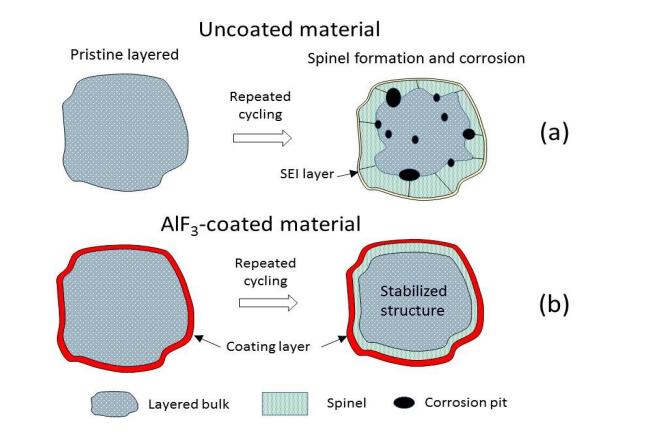









 DownLoad:
DownLoad:
